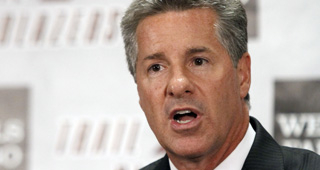It’s hard to tell in the moment who got this offseason right. The Warriors preemptively secured the 2017 title and the Bulls screwed up something fierce, but beyond that, our eyes are still adjusting to the harsh sunlight of a world in which the barely basketball-like stylings of Matthew Dellavedova are worth nearly $40 million. The cash being thrown around in free agency calls to mind an apocryphal story I’ve heard that involves Julia Louis-Dreyfus lightly complaining to a movie theater concession stand employee about the price of popcorn. You’re obscenely rich, the concession guy thought to himself. Then again, $7.50 is a silly rate for a bucket of puffed-up carbs, no matter how much money you have. If $64 million buys you Timofey Mozgov in this market, that’s supply and demand at work, but it’s also objectively just a lot of scrilla to give a seven-footer with knee problems and a substitute teacher’s haircut.
So, $75 million and four years to Allen Crabbe? A smidgen less for Evan Turner? Meyers Leonard pulling down eight figures per annum? We don’t know if the Blazers did fine business this summer, but we know they signed some fine talent, and grabbing Festus Ezeli for two years and $15 million was one of the shrewdest moves in a free agency period marked by splashy ones. Whether Neil Olshey’s spending prove reckless, frugal, or somewhere in between, he at least approached the offseason with clear intent to gather youngish talent.
The Blazers probably have a little bit too much of it, in fact: they’ve got a bit of big man logjam and Turner needs the ball to be at his best, which will likely push C.J. McCollum into spot-up duty more often than the Lehigh grad would like. There are kinks to be ironed out by Terry Stotts, who so far in his head coaching career has been adept at mixing and matching a group of players who haven’t always seemed congruous on paper, but the Blazers are definitely better now than they were when they nabbed a Western Conference four-seed last season.
The same goes for the Jazz, who didn’t have to splurge to grab Joe Johnson (two years, $22 million) and replaced drunk sheriff Trey Burke with a steadier hand in George Hill. It remains to be seen whether they can coax another good year out of Boris Diaw or if he’s going to post up at Salt Lake City’s foremost charcuterie and effectively retire. Motivated Boris or no, one of the league’s best defensive teams now has Johnson backing up Rodney Hood and Gordon Hayward, Hill and Shelvin Mack running point, and they can allow Dante Exum to get in wherever he fits as he returns from a nasty knee injury. Add that to Rudy Gobert and Derrick Favors, and the Jazz have a squad that can make some noise. At the very least, they’ll be fitfully unpleasant opponents.
The Pelicans are notable for showing some restraint for the first time since drafting Anthony Davis. I wrote a few months back that New Orleans had essentially followed the failed rush-job title contender strategy the Cavaliers employed during LeBron James’s first spell in Cleveland. They drafted their savior and got way out in front of themselves, overpaying free agents and flipping first-rounders for vets.
Fortunately for the Pels, Davis is locked into a long-term deal that gives them plenty of time to fix their mistakes, and that’s what they’ve set about doing this summer. They let Ryan Anderson and Eric Gordon walk and they signed a few of what in this financial climate can be considered economy contracts. Solomon Hill (four years, $48 million), E’twaun Moore (four years, $34 million) and Langston Galloway (two years, $10 million) aren’t bad players, but perhaps most importantly, they’re not hamstringingly expensive. Hill, Moore and Galloway will provide competence at a fair rate, which isn’t unimportant for a team that finished last season trotting out lineups laden with D-Leaguers. If everything breaks right, the Pels will head into the summer of 2017 coming off a decent season with some $30 million in cap space to spend on a fertile free agent class.
Whether any of these teams will so much as sniff a title in the next few years will depend almost entirely on whether the Warriors stay together or if they’re a short-term superteam. There’s nothing the Blazers, Jazz or Pelicans can do that would effectively counter Golden State nearly running out an All-NBA team as a starting lineup. It is heartening, though, that a handful of relatively young teams from the NBA’s middle class have decided they might as well go about the business of improvement anyway.
It’s easy, with a juggernaut blotting out the sun, for a franchise’s braintrust to talk themselves into a one-year tank job, angering their players who are already under contract and deflating their fans for an outside shot at a teenaged star. It’s nobler and altogether more fun to instead spruce up the roster and see just how good the team can be, even if they don’t top out at a championship level. This coming season, the Blazers, Jazz and Pelicans will grow up a little bit or a lot, and that will be worth keeping track of for the simple fact that it’s satisfying to watch players and squads figure themselves out. It is, in fact, one of the only compelling arguments for why the NBA’s calendar is so damn extensive. In mid-January, when the league gets sleepy and its titans are coasting, we’ll thank Naismith for the overmatched franchises who gave this upcoming year their best shot.



